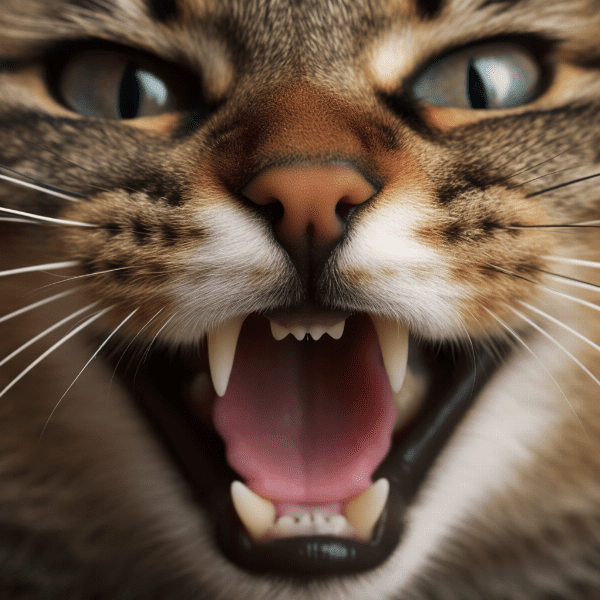Table of Contents
- Introduction to Feline Gum Disease
- Understanding the Causes of Feline Gum Disease
- Signs and Symptoms of Feline Gum Disease
- Diagnosis of Feline Gum Disease
- Prevention of Feline Gum Disease
- Home Remedies for Feline Gum Disease
- Professional Treatments for Feline Gum Disease
- Complications and Risks Associated with Feline Gum Disease
- Importance of Regular Dental Check-ups for Cats
- Conclusion and Key Takeaways.
Introduction to Feline Gum Disease
Cats are notorious for their grooming habits, but unfortunately, their dental hygiene often goes overlooked. Gum disease is a common dental problem in cats, affecting up to 70% of cats over the age of three. While it may seem like a minor issue, gum disease can lead to severe health problems if left untreated. In this section, we’ll discuss the basics of feline gum disease, including its causes, symptoms, and potential complications.
What is Feline Gum Disease?
Feline gum disease, also known as periodontal disease, is an inflammatory condition that affects the gums and other tissues that support the teeth. The disease occurs when plaque and bacteria accumulate on the teeth, leading to inflammation and infection. Over time, the inflammation can damage the gums and other supporting tissues, causing tooth loss and other complications.
Causes of Feline Gum Disease
Several factors can contribute to the development of feline gum disease, including poor dental hygiene, genetics, and diet. Cats that consume a diet high in carbohydrates are more likely to develop gum disease, as are those that don’t receive regular dental care.
Symptoms of Feline Gum Disease
The early stages of feline gum disease can be difficult to detect, but as the disease progresses, several symptoms may become apparent. These can include bad breath, swollen or bleeding gums, and loose teeth. Cats may also experience difficulty eating or lose interest in their food altogether.
Potential Complications of Feline Gum Disease
Left untreated, feline gum disease can lead to a range of complications, including tooth loss, oral infections, and even systemic infections that can affect other parts of the body. In some cases, gum disease can also lead to heart disease and other serious health problems.
In summary, feline gum disease is a common and potentially serious condition that can cause a range of health problems for cats. In the following sections, we’ll discuss the causes, symptoms, and treatments for this condition in more detail, so that you can take the necessary steps to keep your furry friend healthy and happy.
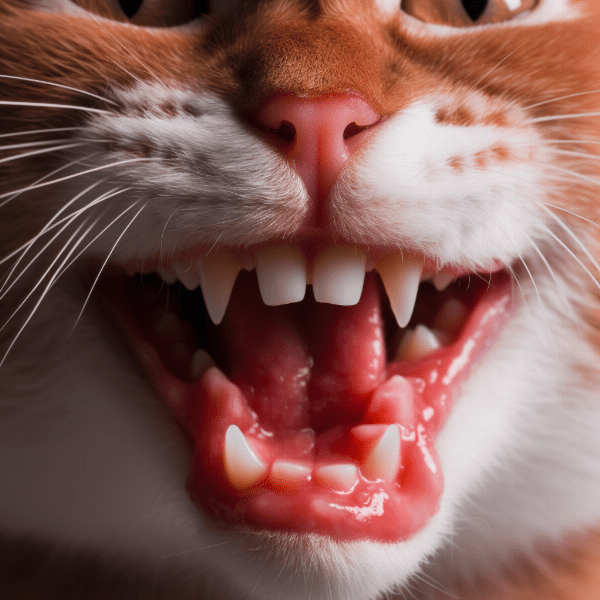
Understanding the Causes of Feline Gum Disease
As mentioned earlier, feline gum disease is a result of plaque and bacteria accumulation in the teeth. In this section, we’ll take a closer look at the causes of this condition.
Poor Dental Hygiene
The primary cause of feline gum disease is poor dental hygiene. When cats don’t receive regular dental care, plaque and bacteria can accumulate on their teeth, leading to inflammation and infection. It’s essential to brush your cat’s teeth regularly and take them for dental checkups to prevent gum disease.
Genetics
Some cats are more prone to gum disease due to genetics. Certain breeds, such as Siamese and Abyssinians, may be more susceptible to the condition. Additionally, cats with certain medical conditions, such as feline immunodeficiency virus (FIV), may be more prone to developing gum disease.
Diet
Diet plays a crucial role in the development of feline gum disease. Cats that consume a diet high in carbohydrates are more likely to develop plaque and tartar buildup on their teeth. Additionally, dry food may be more likely to stick to a cat’s teeth, leading to the development of plaque and tartar.
Other Factors
Other factors can also contribute to the development of feline gum disease. For example, age is a significant risk factor, as older cats are more likely to develop the condition. Additionally, cats that have had previous dental problems may be more prone to developing gum disease.
In summary, several factors can contribute to the development of feline gum disease, including poor dental hygiene, genetics, diet, age, and previous dental problems. By understanding these causes, you can take steps to prevent gum disease in your cat and keep their teeth healthy.
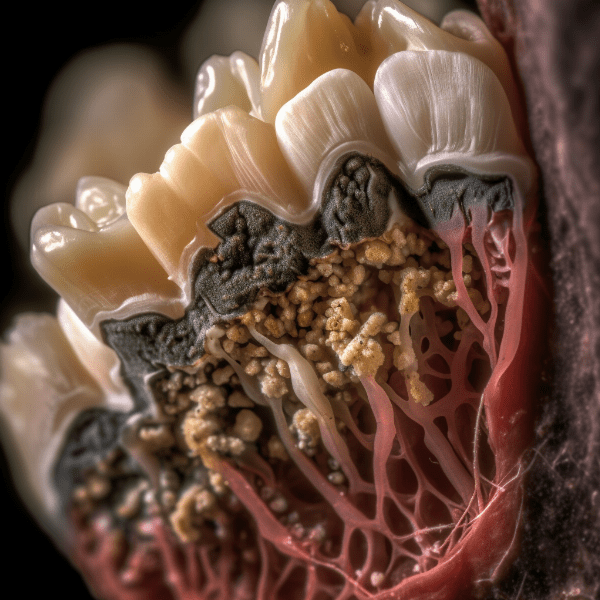
Signs and Symptoms of Feline Gum Disease
As with many health conditions, early detection is key to successfully treating feline gum disease. In this section, we’ll discuss the signs and symptoms of this condition that you should look out for.
Bad Breath
One of the most common signs of feline gum disease is bad breath. If your cat’s breath smells noticeably worse than usual, it may be a sign that their teeth and gums are not in good health.
Swollen or Bleeding Gums
Gums that are swollen or bleeding are also a sign of feline gum disease. If you notice that your cat’s gums look red, inflamed, or bleed easily, it’s time to take them to the vet for an evaluation.
Loose Teeth
In advanced cases of feline gum disease, teeth may become loose or even fall out. If you notice that your cat has missing teeth or is having trouble eating, it’s essential to get them to the vet as soon as possible.
Difficulty Eating
Cats with gum disease may experience pain or discomfort when eating. If your cat seems to be having trouble chewing their food or avoids certain types of food altogether, it could be a sign of gum disease.
.
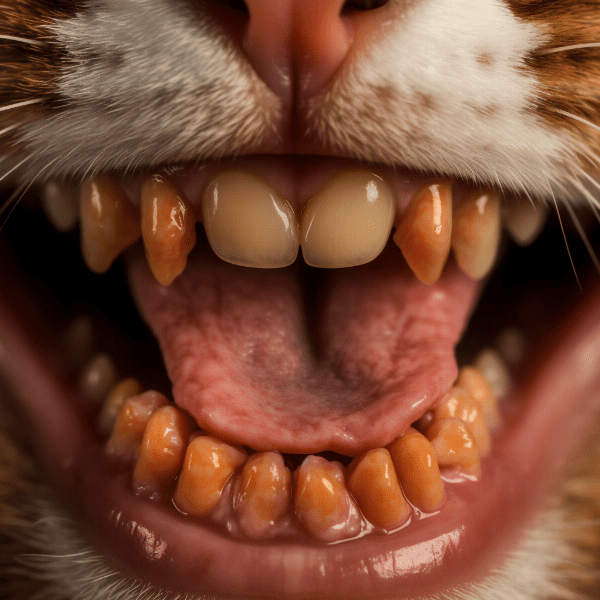
Diagnosis of Feline Gum Disease
If you suspect that your cat has gum disease, it’s essential to take them to the vet for a proper diagnosis. In this section, we’ll discuss the steps that your vet may take to diagnose feline gum disease.
Physical Examination
The first step in diagnosing feline gum disease is a physical examination. During the exam, your vet will check your cat’s teeth and gums for signs of inflammation, swelling, or bleeding. They may also take X-rays to assess the extent of the damage and to check for other underlying dental problems.
Oral Examination
In addition to the physical exam, your vet may also perform an oral examination to assess your cat’s dental health. This may involve probing the gums to check for pockets or areas of inflammation, as well as examining the teeth for signs of decay or damage.
Blood Work
Blood work may also be necessary to diagnose feline gum disease. Your vet may perform a complete blood count (CBC) or a blood chemistry panel to check for signs of infection or other underlying health problems that may be contributing to your cat’s gum disease.
Biopsy
In some cases, a biopsy may be necessary to confirm a diagnosis of feline gum disease. A small sample of tissue may be taken from the affected area and examined under a microscope to determine the extent of the damage and to rule out other possible causes of the symptoms.
In summary, diagnosing feline gum disease typically involves a combination of physical and oral examinations, blood work, and in some cases, a biopsy. If you suspect that your cat may have gum disease, it’s essential to take them to the vet for a proper diagnosis and treatment plan.

Prevention of Feline Gum Disease
Preventing feline gum disease is key to keeping your cat’s teeth healthy and avoiding potentially serious health problems. In this section, we’ll discuss some of the steps you can take to prevent gum disease in your cat.
Regular Dental Care
The most important step in preventing feline gum disease is to maintain regular dental care for your cat. This includes brushing their teeth regularly, ideally every day, with a cat-specific toothbrush and toothpaste. You can also provide dental treats or chews designed to help remove plaque and tartar from your cat’s teeth.
Healthy Diet
A healthy diet can also help prevent feline gum disease. Cats that consume a diet high in protein and low in carbohydrates are less likely to develop plaque and tartar buildup on their teeth. Additionally, wet food can help keep your cat’s mouth clean and hydrated, reducing the risk of gum disease.
Professional Dental Cleanings
In addition to at-home dental care, regular professional dental cleanings can also help prevent feline gum disease. Your vet may recommend regular cleanings every 6 to 12 months, depending on your cat’s individual needs.
Routine Check-Ups
Routine check-ups with your vet are also essential in preventing feline gum disease. During these visits, your vet can assess your cat’s dental health and identify any potential issues before they progress.
Monitoring for Symptoms
Finally, monitoring your cat for signs and symptoms of gum disease can also help prevent the condition from progressing. If you notice any of the symptoms discussed earlier, such as bad breath or swollen gums, it’s essential to take your cat to the vet for evaluation and treatment.
In summary, regular dental care, a healthy diet, professional dental cleanings, routine check-ups, and monitoring for symptoms are all essential steps in preventing feline gum disease. By taking these steps, you can help keep your cat’s teeth healthy and avoid potentially serious health problems.
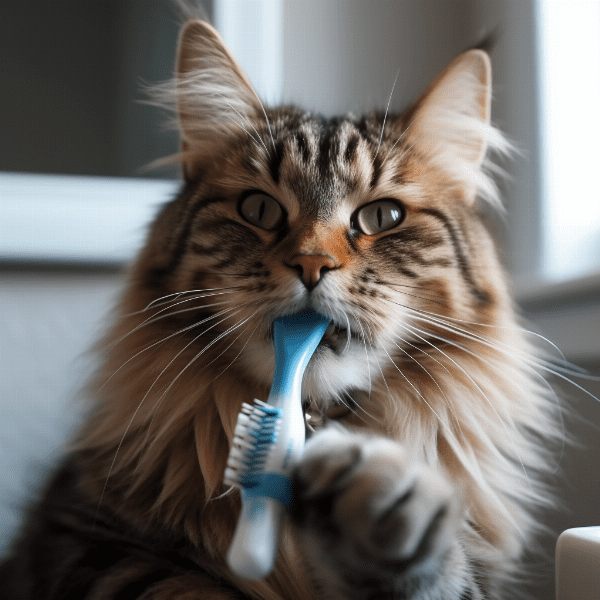
Home Remedies for Feline Gum Disease
If your cat has been diagnosed with gum disease, there are several home remedies that you can use to help manage the condition. In this section, we’ll discuss some of the most effective home remedies for feline gum disease.
Coconut Oil
Coconut oil has natural antibacterial and anti-inflammatory properties, making it an excellent choice for managing feline gum disease. You can apply a small amount of coconut oil to your cat’s gums and teeth daily to help reduce inflammation and promote healing.
Turmeric
Turmeric is another natural anti-inflammatory that can be used to manage feline gum disease. You can mix a small amount of turmeric with water to create a paste and apply it to your cat’s gums and teeth. Be sure to use a small amount and avoid getting the mixture on your cat’s fur, as it can stain.
Vitamin C
Vitamin C is essential for maintaining healthy gums in cats. You can add a small amount of powdered vitamin C to your cat’s food daily to help support their gum health.
Water Additives
Certain water additives can also help manage feline gum disease. Chlorhexidine is a common ingredient in dental water additives and can help reduce plaque and tartar buildup on your cat’s teeth. Be sure to follow the manufacturer’s instructions when using any water additives.
Dental Rinses
Finally, certain dental rinses can be used to manage feline gum disease. Chlorhexidine is a common ingredient in dental rinses and can be applied directly to your cat’s teeth and gums to help reduce inflammation and promote healing.
In summary, coconut oil, turmeric, vitamin C, water additives, and dental rinses are all effective home remedies for managing feline gum disease. However, it’s important to note that these remedies should be used in conjunction with regular veterinary care and professional dental cleanings. If your cat has been diagnosed with gum disease, be sure to work closely with your vet to develop a comprehensive treatment plan.
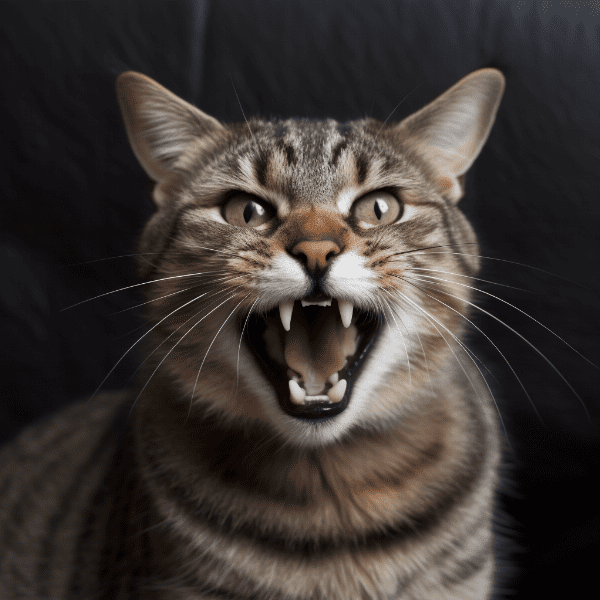
Professional Treatments for Feline Gum Disease
In addition to at-home remedies, there are several professional treatments available for managing feline gum disease. In this section, we’ll discuss some of the most effective treatments for this condition.
Professional Dental Cleaning
One of the most effective treatments for feline gum disease is a professional dental cleaning. During the cleaning, your vet will remove plaque and tartar buildup from your cat’s teeth and gums. They may also perform a deep cleaning to remove any bacteria that has accumulated below the gum line.
Antibiotics
If your cat’s gum disease is caused by a bacterial infection, your vet may prescribe antibiotics to help manage the condition. Antibiotics can help reduce inflammation and promote healing, but they should be used only as directed by your vet.
Periodontal Surgery
In advanced cases of feline gum disease, periodontal surgery may be necessary to manage the condition. During the surgery, your vet will remove any damaged tissue and reposition the gums to reduce inflammation and promote healing.
Tooth Extraction
In some cases, tooth extraction may be necessary to manage feline gum disease. If a tooth is severely damaged or infected, it may need to be removed to prevent the infection from spreading to other teeth and tissues.
Laser Therapy
Finally, laser therapy can also be used to manage feline gum disease. Laser therapy can help reduce inflammation and promote healing, making it an effective treatment option for some cats.
In summary, professional dental cleaning, antibiotics, periodontal surgery, tooth extraction, and laser therapy are all effective treatments for feline gum disease. The most appropriate treatment option will depend on the severity of your cat’s condition, so be sure to work closely with your vet to develop a comprehensive treatment plan.
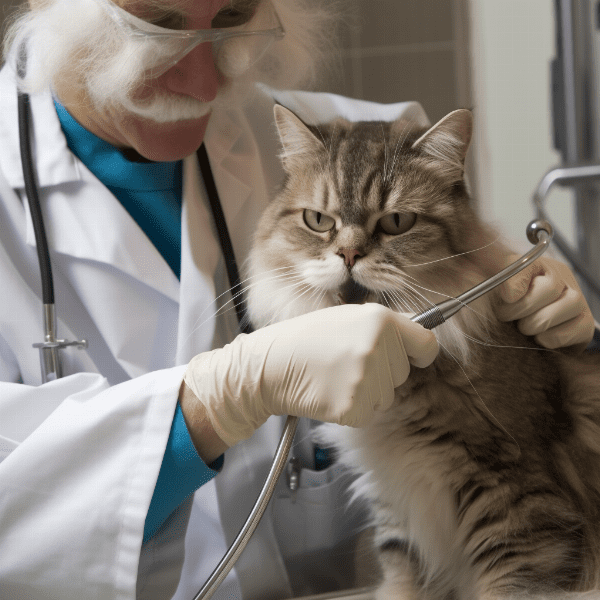
Complications and Risks Associated with Feline Gum Disease
If left untreated, feline gum disease can lead to a range of complications and risks. In this section, we’ll discuss some of the most significant risks associated with this condition.
Tooth Loss
One of the most common complications of feline gum disease is tooth loss. As the disease progresses, the gums may recede, leading to loose teeth that may eventually fall out. This can make it difficult for your cat to eat and may lead to additional health problems.
Infection
Untreated gum disease can also lead to infection. Bacteria that accumulate in the gums can spread to other parts of the body, leading to potentially serious health problems.
Pain and Discomfort
Gum disease can be painful and uncomfortable for your cat, making it difficult for them to eat, drink, or play. If left untreated, this discomfort can significantly impact your cat’s quality of life.
Spread of Infection
Finally, if left untreated, feline gum disease can lead to the spread of infection to other parts of the body. This can lead to potentially serious health problems and may even be life-threatening in some cases.
In summary, feline gum disease can lead to tooth loss, infection, pain and discomfort, and the spread of infection to other parts of the body. If you suspect that your cat has gum disease, it’s essential to take them to the vet for evaluation and treatment to prevent these complications from occurring.

Importance of Regular Dental Check-ups for Cats
Regular dental check-ups are essential for maintaining your cat’s dental health and preventing potentially serious health problems. In this section, we’ll discuss why regular dental check-ups are so important for cats.
Early Detection of Problems
Regular dental check-ups allow your vet to identify any potential dental problems early on, before they have a chance to progress. This can help prevent serious health problems and can save you money on expensive treatments down the road.
Preventative Care
In addition to detecting problems early, regular dental check-ups also allow your vet to provide preventative care for your cat’s teeth and gums. This can include professional cleanings, fluoride treatments, and advice on at-home dental care.
Overall Health
Regular dental check-ups are not just important for your cat’s dental health; they are also essential for their overall health. Gum disease has been linked to a range of health problems, including heart disease, kidney disease, and diabetes. By maintaining your cat’s dental health, you can help prevent these potentially serious health problems.
Behavioral Changes
Finally, regular dental check-ups can also help identify behavioral changes in your cat that may be related to dental problems. If your cat is avoiding certain foods, seems less interested in playing, or is showing signs of pain or discomfort, it may be due to dental problems that can be addressed during a check-up.
In summary, regular dental check-ups are essential for maintaining your cat’s dental health and overall well-being. By detecting problems early, providing preventative care, promoting overall health, and identifying behavioral changes, regular dental check-ups can help keep your cat healthy and happy for years to come.

Conclusion and Key Takeaways.
Feline gum disease is a common condition that can lead to a range of complications and health problems if left untreated. In this guide, we’ve discussed the causes, symptoms, diagnosis, treatment, and prevention of feline gum disease, as well as the importance of regular dental check-ups for cats.
Some key takeaways from this guide include:
- Feline gum disease is caused by the buildup of plaque and tartar on your cat’s teeth and gums.
- Symptoms of feline gum disease include bad breath, swollen or bleeding gums, and loose teeth.
- Diagnosing feline gum disease typically involves a combination of physical and oral examinations, blood work, and in some cases, a biopsy.
- Preventing feline gum disease involves maintaining regular dental care, providing a healthy diet, scheduling routine check-ups, and monitoring for symptoms.
- Home remedies for feline gum disease include coconut oil, turmeric, vitamin C, water additives, and dental rinses.
- Professional treatments for feline gum disease include professional dental cleaning, antibiotics, periodontal surgery, tooth extraction, and laser therapy.
- Complications of feline gum disease include tooth loss, infection, pain and discomfort, and the spread of infection to other parts of the body.
- Regular dental check-ups are essential for maintaining your cat’s dental health and overall well-being.
In conclusion, by taking the steps outlined in this guide, you can help prevent feline gum disease and keep your cat’s teeth healthy and happy. If you suspect that your cat may have gum disease, be sure to take them to the vet for evaluation and treatment. With proper care and attention, you can help ensure that your cat enjoys a long and healthy life.



